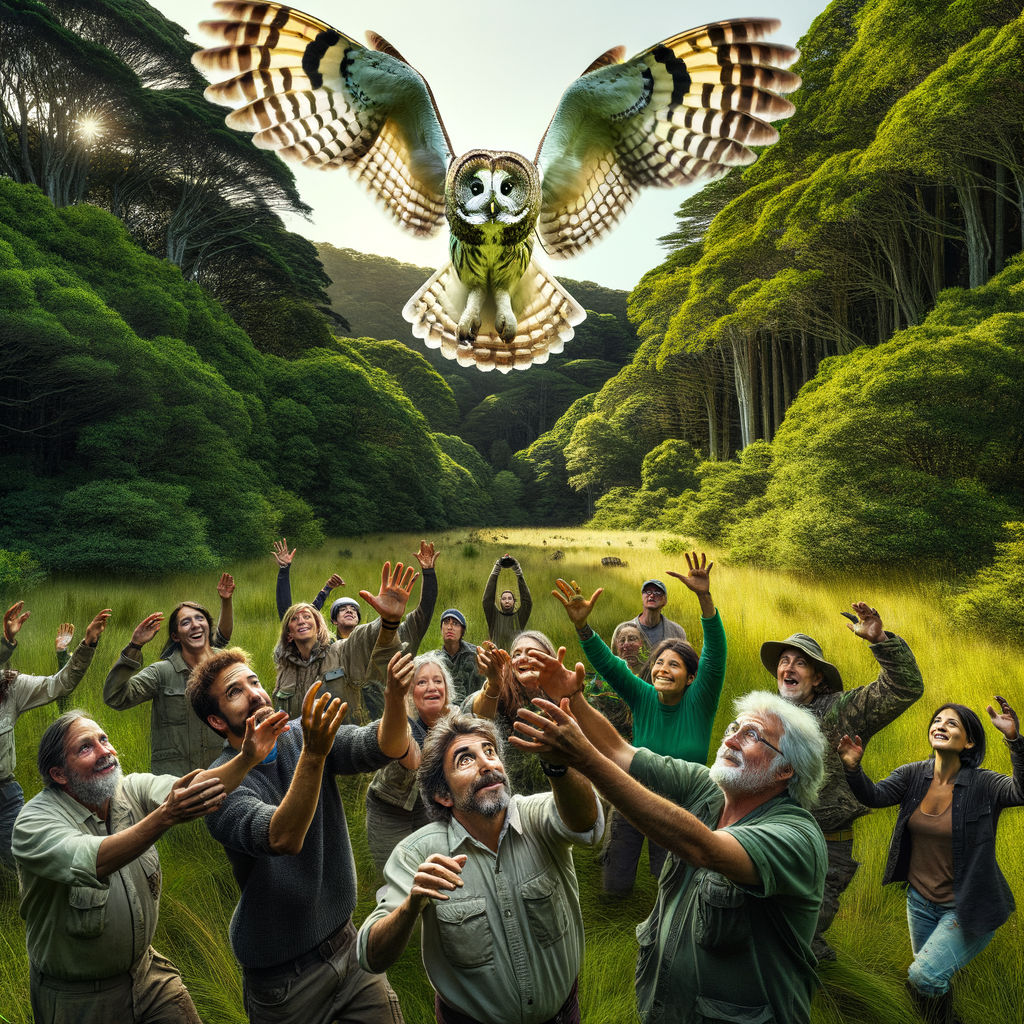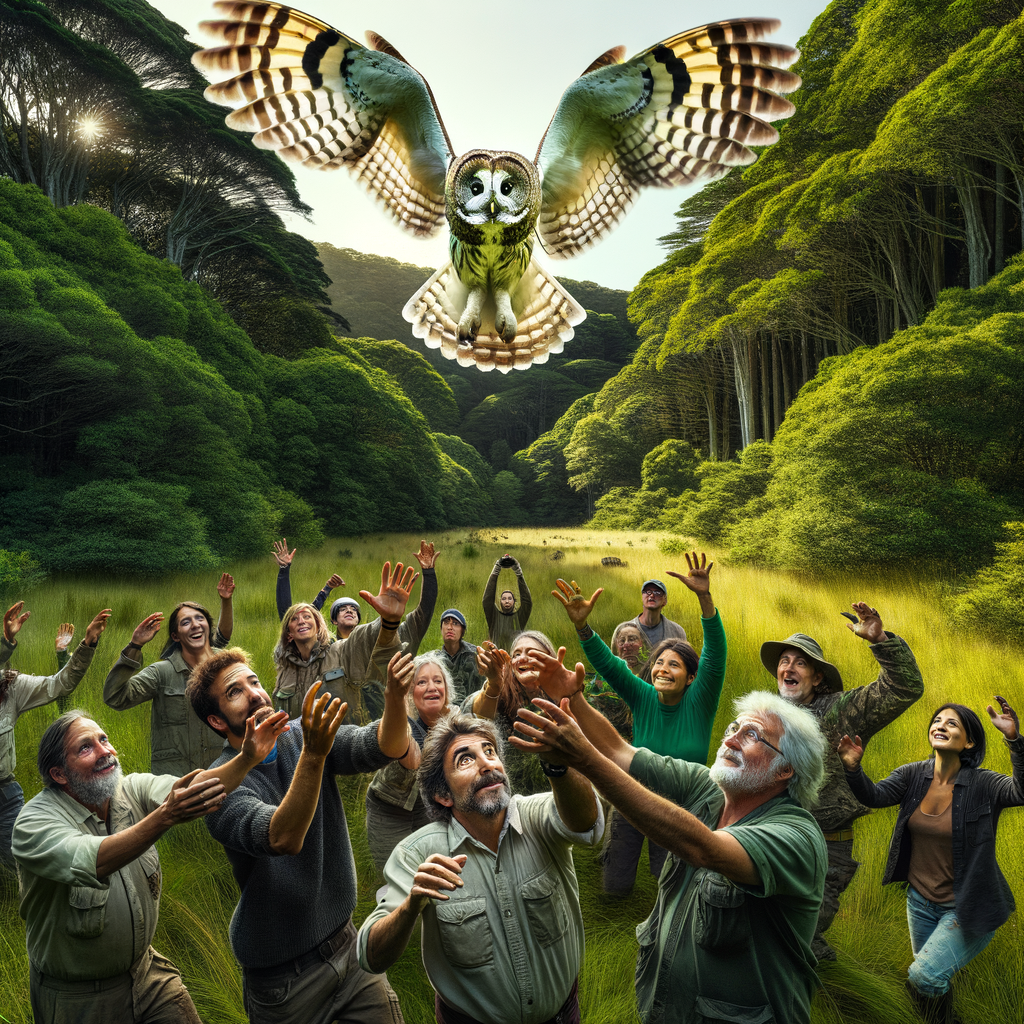
Introduction to Reintroducing Owls to the Wild
- The concept of wildlife reintroduction: This helps restore the balance of ecosystems. It involves careful planning and monitoring to ensure the animals can survive and thrive.
- The importance of reintroducing owls to the wild: Owls play a crucial role in controlling rodent populations. By reintroducing owls, we can help maintain healthy ecosystems. This also supports biodiversity, which is vital for the environment.
- Overview of owl conservation challenges: Owls face many threats, such as habitat loss, pollution, and climate change. Conservation efforts aim to address these challenges. Protecting their habitats and reducing human impact are key steps in helping owl populations recover.
Owl Conservation Challenges
Endangered Owl Species
-
- Identifying Endangered Owl Species
Some of these species are in danger of disappearing. Scientists work hard to find out which owls are endangered. They use special tools and methods to track owl populations. For example, the Spotted Owl is one such species that is closely monitored.
-
- Understanding the Threats to These Species
One big threat is habitat loss. When forests are cut down, owls lose their homes. Another threat is pollution. Chemicals in the air and water can harm owls. Climate change also affects owl habitats. For instance, the Barn Owl faces challenges due to changing weather patterns.
| Owl Species | Status | Main Threats |
|---|---|---|
| Spotted Owl | Endangered | Habitat Loss, Climate Change |
| Barn Owl | Vulnerable | Pollution, Habitat Loss |
Owl Habitat Restoration
- Importance of habitat restoration in owl conservationOwls need specific environments to hunt, nest, and thrive. When their habitats are destroyed, owls struggle to survive. By restoring these areas, we help protect these amazing birds.
For example, the Northern Spotted Owl lives in old-growth forests. These forests are often cut down for timber. Restoring these forests helps the owls find food and shelter.
Owl Species Habitat Type Restoration Efforts Burrowing Owl Grasslands Planting native grasses Barn Owl Farmlands Building nest boxes Snowy Owl Tundra Protecting nesting sites -
Challenges in restoring owl habitats
One big challenge is human activity. People build homes, roads, and farms in owl habitats. This makes it hard to find places to restore.
Another challenge is climate change. As the climate changes, the places where owls live can become too hot or too cold. This makes it harder for owls to find food and shelter.
Finally, it can be expensive to restore habitats. Planting trees, cleaning up pollution, and protecting land costs a lot of money. But these efforts are important to help owls survive.
Wildlife Reintroduction Programs
Owl Population Recovery Efforts
Reintroducing owls to the wild is a crucial part of wildlife conservation. Here, we will look at some successful owl population recovery programs and the key takeaways from these efforts.
- Case study: Successful owl population recovery programsOne notable example is the Barn Owl recovery program in the United Kingdom. This program has helped increase the barn owl population by 280% over the last decade. Conservationists used nest boxes and habitat management to achieve this success.
Another example is the Northern Spotted Owl recovery in the United States. This program focused on protecting old-growth forests, which are crucial for the owls’ survival. The population has shown a steady increase due to these efforts.
-
Key takeaways from these programs
- Habitat Management: Creating and maintaining suitable habitats is essential. This includes providing nest boxes and protecting old-growth forests.
- Community Involvement: Engaging local communities can help in monitoring and protecting owl habitats.
- Long-term Commitment: Recovery programs need time and consistent effort to show results. Patience and persistence are key.
| Program | Location | Success Rate | Key Strategies |
|---|---|---|---|
| Barn Owl Recovery | United Kingdom | 280% increase | Nest boxes, habitat management |
| Northern Spotted Owl Recovery | United States | Steady increase | Forest protection, community involvement |
Owl Release Strategies
-
Planning and Executing Owl Release Strategies
First, experts choose a safe location. This place should have enough food and shelter for the owls. Next, they check if the area has other owls. Too many owls in one place can cause problems.
Before release, owls need to be healthy. Vets check them for diseases. They also make sure the owls can hunt and fly well. Sometimes, owls are fitted with tracking devices. This helps scientists monitor their movements.
One example of a successful release is the Barn Owl project in the UK. In this project, many barn owls were released into the wild. The population of barn owls grew, showing that careful planning works.
-
Challenges in Implementing Owl Release Strategies
One big challenge is finding the right habitat. Many natural habitats are shrinking due to human activities. This makes it hard to find safe places for owls.
Another challenge is human interference. Sometimes, people disturb the owls or their habitats. This can make it hard for the owls to survive. Pollution is also a problem. Chemicals in the environment can harm the owls.
Weather can also be a challenge. Harsh weather conditions can make it difficult for owls to find food and shelter. For example, heavy rains or snow can affect their hunting abilities.
Despite these challenges, many organizations are working hard to overcome them. With continued efforts, we can help owls thrive in the wild.
Rewilding Efforts for Owls
Ecological Impact of Owl Reintroduction
-
- The ecological impact of reintroducing owls
Reintroducing owls into the wild can have a big impact on the ecosystem. Owls are predators, and they help control the population of small animals like mice and insects. This balance is important for a healthy environment.
-
- Case study: Ecological changes after owl reintroduction
In a study conducted in Yellowstone National Park, scientists reintroduced a group of owls. Over the next few years, they observed several changes:
| Change | Impact |
|---|---|
| Decrease in rodent population | Less crop damage and fewer diseases |
| Increase in plant growth | Healthier forests and fields |
| More biodiversity | Better habitat for other animals |
This case study shows that reintroducing owls can lead to positive ecological changes. It highlights the importance of these birds in maintaining a balanced ecosystem.
Owl Survival in the Wild
-
Factors affecting owl survival in the wild
Owls face many challenges in the wild. These factors can make it hard for them to survive:
-
-
- Habitat Loss: When forests are cut down, owls lose their homes.
- Food Scarcity: Owls need plenty of small animals to eat. If there are fewer mice or insects, owls can go hungry.
- Predators: Larger animals, like hawks or eagles, can hunt owls.
- Climate Change: Changes in weather can affect where owls can live and find food.
-
-
Strategies to enhance owl survival rates
There are ways to help owls survive better in the wild. Here are some strategies:
-
- Protecting Habitats: Saving forests and other natural areas gives owls a place to live.
- Providing Food Sources: Ensuring there are enough small animals for owls to eat helps them stay healthy.
- Reducing Predators: Keeping larger predators away from owl habitats can protect them.
- Climate Action: Fighting climate change helps keep the environment stable for owls.
| Factor | Impact on Owls |
|---|---|
| Habitat Loss | Loss of nesting and hunting grounds |
| Food Scarcity | Difficulty finding enough food |
| Predators | Increased risk of being hunted |
| Climate Change | Altered living conditions |
By understanding these factors and using these strategies, we can help owls thrive in the wild.
Conclusion: The Future of Owl Conservation
-
Reflecting on the Challenges and Successes of Reintroducing Owls to the Wild
One major challenge is habitat loss. Owls need large areas of forests to live and hunt. When forests are cut down, owls lose their homes.
Another challenge is finding enough food. Owls eat small animals like mice and insects. If these animals are not around, owls can’t survive. But there have been successes too. For example, the Barn Owl population has increased in some areas due to conservation efforts.
Programs that protect owl habitats and provide food sources have helped. These programs also educate people about the importance of owls in the ecosystem.
-
Looking Forward: Future Strategies for Owl Conservation
One strategy is to create more protected areas where owls can live safely. These areas will have plenty of trees and food sources. Another strategy is to use technology. For example, scientists can use GPS trackers to monitor owl movements. This helps them understand what owls need to survive.
Education is also key. Teaching people about owls and their role in the environment can lead to better protection efforts. Schools and communities can get involved in conservation projects.
Here is a table showing some key strategies for future owl conservation:
Strategy Details Protected Areas Create safe habitats with plenty of trees and food. Use of Technology Monitor owl movements with GPS trackers. Education Teach people about the importance of owls.






